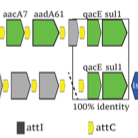Link to online paper: https://academic.oup.com/gigascience/article/doi/10.1093/gigascience/giaa125/5992824
Abstract
Background: Wastewater treatment is an essential tool for maintaining water quality in urban environments. While the treatment of wastewater can remove most bacterial cells, some will inevitably survive treatment to be released into natural environments. Previous studies have investigated antibiotic resistance within wastewater treatment plants, but few studies have explored how a river’s complete set of antibiotic resistance genes (the “resistome”) is affected by the release of treated effluent into surface waters. Results: Here we used high-throughput, deep metagenomic sequencing to investigate the effect of treated wastewater effluent on the resistome of an urban river and the downstream distribution of effluent-associated antibiotic resistance genes and mobile genetic elements. Treated effluent release was found to be associated with increased abundance and diversity of antibiotic resistance genes and mobile genetic elements. The impact of wastewater discharge on the river’s resistome diminished with increasing distance from effluent discharge points. The resistome at river locations that were not immediately downstream from any wastewater discharge points was dominated by a single integron carrying genes associated with resistance to sulfonamides and quaternary ammonium compounds. Conclusions: Our study documents variations in the resistome of an urban watershed from headwaters to a major confluence in an urban center. Greater abundances and diversity of antibiotic resistance genes are associated with human fecal contamination in river surface water, but the fecal contamination effect seems to be localized, with little measurable effect in downstream waters. The diverse composition of antibiotic resistance genes throughout the watershed suggests the influence of multiple environmental and biological factors.
